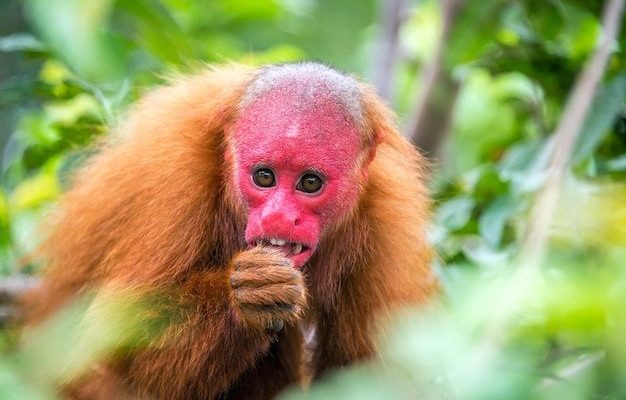
Imagine sitting in a café, sipping your coffee, and chatting about wildlife. You might casually mention how some animals are thriving while others are barely hanging on. That’s the situation with the uakari. Understanding its endangered status helps us appreciate the delicate balance of nature and what we can do to protect it. So, let’s break down this pressing issue, looking at its habitat, threats, conservation efforts, and what we can all do to help!
What is a Uakari?
To get a better grasp of why the uakari is important, let’s first understand what it actually is. The uakari is a type of monkey that lives in the flooded forests of the Amazon River basin. They’re part of the Cacajao family and are known for their distinctive red or bald faces. This unique look isn’t just for show; it plays a role in their social interactions and mating rituals.
Uakaris are primarily herbivores, munching on fruits, nuts, and seeds. They have a pretty friendly demeanor but can also be incredibly social. These monkeys live in groups, which helps protect them from predators. Their communities are fascinating to observe; you can see them play, groom each other, and communicate in various ways.
Honestly, uakaris are not just cute; they’re part of a delicate ecosystem. They help disperse seeds in the rainforest, which is crucial for plant growth and biodiversity. Without them, the forest may not thrive as it does today, showing how every species has a role in maintaining ecological balance.
Is the Uakari Endangered? An Overview
You might be wondering, “So, is the uakari endangered?” The short answer is yes, they are considered vulnerable, with some species classified as endangered. Their populations have been declining due to various threats, making it crucial to understand what’s going on.
The main issues facing uakaris stem from habitat loss. Deforestation for agriculture, logging, and urban development has significantly reduced their living space. Imagine being uprooted from your home due to something you can’t control—this is the reality for many uakaris. As their forests shrink, so do their chances for survival.
Moreover, climate change is throwing additional hurdles in their path. Increased flooding, droughts, and temperature changes disrupt their habitat and food sources. It’s a double whammy that puts immense pressure on these adorable monkeys, making conservation efforts more critical than ever.
Key Threats to Uakari Populations
Understanding the threats to uakaris helps us realize why immediate action is needed. Here are some primary reasons behind the decline of uakari populations:
- Deforestation: As mentioned, the cutting down of forests for farming and development is a major threat. This not only takes away their homes but also reduces the food supply.
- Mining: The quest for gold and other minerals in the Amazon leads to further habitat destruction. This often involves large machinery that devastates the landscape.
- Poverty and Local Communities: Sometimes, local communities depend on logging or farming for their survival, which creates a conflict. They may not realize the long-term impact on the uakari and their ecosystems.
Each of these threats contributes to a grim picture for the uakari’s future. It’s a complex issue that requires collaboration between conservationists, governments, and local communities to navigate effectively.
Current Conservation Efforts
So, what’s being done to help these incredible animals? Conservation efforts are underway, and they’re showing promise. Various organizations are working to protect uakaris and their habitats through several strategies:
- Protected Areas: Establishing reserves and protected areas is crucial. These safe spaces allow uakaris to thrive without the immediate threat of deforestation or human interference.
- Community-Based Conservation: Engaging local communities in conservation efforts is key. When people understand the importance of uakaris and their ecosystems, they’re more likely to take action to protect them.
- Research and Education: Ongoing research helps scientists better understand the uakari’s needs and behaviors. Education initiatives aim to raise awareness about their plight and the importance of biodiversity.
Overall, these efforts show that with the right approach, it’s possible to make a positive impact. But there’s still much work to be done, and everyone can help in some way.
How You Can Help the Uakari
You might feel a bit helpless thinking about the challenges uakaris face, but there are concrete steps you can take to make a difference. Here are some simple yet effective ways to contribute:
- Support Conservation Organizations: Donating to reputable wildlife conservation groups that focus on the Amazon can make a significant difference.
- Educate Yourself and Others: Knowledge is power! Share what you learn about uakaris with friends and family to raise awareness.
- Be Eco-Conscious: Practice sustainable living. Reduce your consumption of products linked to deforestation, such as certain types of palm oil.
Every little bit helps! You don’t need to be a wildlife expert to create change—just being aware and taking small steps can add up to significant results.
The Future of the Uakari
Looking ahead, the future of the uakari hinges on our collective efforts. It’s essential to build a world where humans and wildlife can coexist peacefully. Conservation is not just about saving a single species; it’s about maintaining the rich tapestry of life on our planet.
While the challenges are daunting, there’s hope. With the right strategies and community involvement, we can help ensure that future generations will also have the chance to marvel at the lively antics of uakaris in their natural habitat.
In conclusion, the plight of the uakari is a reminder of how intertwined our lives are with the environment. As we navigate the modern world, let’s not forget about these unique creatures that share our planet. Together, we can make a difference!

